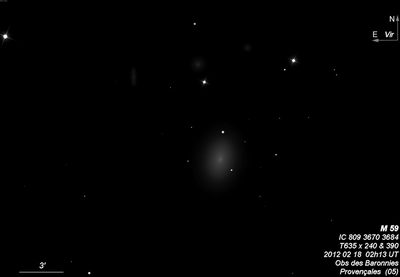
Johann Koehler discovered M59 = NGC 4621 = h1386, along with M60, on 11 Apr 1779. It was independently found by Charles Messier 4 nights later. On 17 Apr 1784 (sweep 199), William Herschel recorded "pB, R, not S, mbM." John Herschel made 3 observations and logged on 4 Apr 1831 (sweep 338), "vB; S; lE; vsvmbM; 2' l, 1 1/2' br."
300/350mm - 13.1" (5/14/83): bright, slightly elongated N-S, bright core. M60 lies 25' E and NGC 4606/4607 is 20' NW.
400/500mm - 17.5" (4/25/87): very bright, moderately large, oval NNW-SSE, 3'x2', small very bright core, stellar nucleus. A mag 15 star is at the SW edge and a brighter mag 13 star is off the north end 1.9' from center. The NGC 4606/NGC 4607 pair lies 20' NW.
600/800mm - 24" (5/22/17): at 200x and 375x; extremely bright, very large, oval 4:3 or 3:2 NNW-SSE. Strongly concentrated with a very bright roundish core and an intensely bright quasi-stellar nucleus. The core/nucleus is within a brighter central region, but then the surface brightness drops sharply with a very low surface brightness outer halo that extends 3.5'x2.5' NNW-SSE. A mag 12 star is at the north edge of the halo. IC 809 = IC 3672 lies 6.5' NNE, just north of an 11th magnitude star.
900/1200mm - 48" (4/19/17): at 697x; extremely bright, very large, oval nearly 3:2 NNW-SSE. Contains a very bright elongated core and an intensely luminous nucleus.
UCD 3, the brightest ultra-compact dwarf in M59 (considered the remnant nucleus of a recently accreted galaxy) was easily visible continuously as a mag 16.4 "star 2.2' E of the center of M59. It forms a pair with a slightly fainter mag 16.5-17 star 20" NW. This object was announced in 2015 as the densest known galaxy!
UCD 1, located just 1.4' SW of the center of M59, appeared as a very faint, possibly "soft" star, just visible continuously with averted vision. It forms a wide pair with a slightly brighter mag 16.5 star 0.5' NW.
IC 809 = IC 3672, 6.6' NNE of M59, appeared moderately to fairly bright, fairly large, slightly elongated 5:4 NW-SE, contains a large brighter core but no nucleus, and a low surface brightness outer halo ~50"x40". A mag 10.9 star is 1.2' SSW.
Notes by Steve Gottlieb